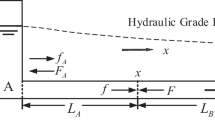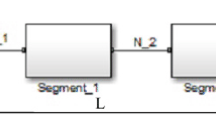Abstract
An accurate prediction of propagation speed and the magnitude induced pressure in water hammer is very critical for the analysis, design, and operation of pipeline transmissions. A new numerical scheme based on an implicit discretization of the method of characteristics solution (IMOC) was proposed in this study. The numerical results were compared with the experimental data and the explicitly discretized solution of the method of characteristics (MOC). Due to the transient nature of the problem, accurate estimation of the head loss can significantly alter the performance of numerical models. In this regards, the performance of both numerical models (i.e., MOC and IMOC) were tested. Four equations were employed based on the steady, quasi-steady, unsteady, and the simplified unsteady algorithms. An acceptable prediction of pressure head with a minimum relative error of −2% and a maximum error of 11% was achieved by using a quasi-steady algorithm for prediction of head loss term in the IMOC model whereas, the relative error of the MOC model was between −11% and +30%. The IMOC model in combination with the simplified unsteady algorithm for estimation of the head loss term had an error range between −20% and +2%, whereas the error range of the MOC model was between −35% and −3%. The numerical results indicated that the MOC model is less accurate than the IMOC in properly modeling the wave propagation speed which resulted in a time lag accumulation between numerical results and the measurements. It was found that the best combination of the numerical scheme and the head loss prediction equation was the IMOC model and the unsteady algorithm, which accurately simulated the time-history of pressure head within ±3% error.





Similar content being viewed by others
Availability of Data and Materials
Data and material are available upon request to the corresponding author.
References
Adamkowski A, Lewandowski M (2006) Experimental examination of unsteady friction models for transient pipe flow simulation. https://doi.org/10.1115/1.2354521
Afshar M, Rohani M (2008) Water hammer simulation by implicit method of characteristic. Int J Press Vessels Pip 85:851–859. https://doi.org/10.1016/j.ijpvp.2008.08.006
Azimi AH, Zhu DZ, Rajaratnam N (2011) Effect of particle size on the characteristics of sand jet in water. J Eng Mech, ASCE, 137(12):822–834
Azimi AH, Zhu DZ, Rajaratnam N (2012a) Experimental study of sand jet front in water. Int J Multiphase Flow 40:19–37
Azimi AH, Zhu DZ, Rajaratnam N (2012b) Computational investigation on vertical slurry jets. Int J Multiphase Flow 47:94–114
Bergant A, Ross Simpson A, Vìtkovsk J (2001) Developments in unsteady pipe flow friction modelling. J Hydraul Res 39:249–257. https://doi.org/10.1080/00221680109499828
Bostan, M., Akhtari, A.A., Bonakdari, H., 2018. Deriving the governing equation for a shock damper to model the unsteady flow caused by sudden valve closure and sudden demand change. J Water Supply Res Technol AQUA 67:202–210. https://doi.org/10.2166/aqua.2017.116
Bostan M, Akhtari AA, Bonakdari H, Gharabaghi B, Noori O (2020) Investigation of a new shock damper system efficiency in reducing water hammer excess pressure due to the sudden closure of a control valve. ISH J Hydraul Eng 26:258–266. https://doi.org/10.1080/09715010.2018.1479665
Bostan M, Akhtari AA, Bonakdari H, Jalili F (2019) Optimal design for shock damper with genetic algorithm to control water hammer effects in complex water distribution systems. Water Resour Manag 33:1665–1681. https://doi.org/10.1007/s11269-019-2192-9
Chamani M, Pourshahabi S, Sheikholeslam F (2013) Fuzzy genetic algorithm approach for optimization of surge tanks. Sci Iran 20:278–285. https://doi.org/10.1016/j.scient.2013.04.002
Chaudhry MH (1979) Applied hydraulic transients. Springer
Elger DF, Roberson JA (2013) Engineering fluid mechanics. Wiley Hoboken (NJ)
Fathi-Moghadam M, Haghighipour S, Vali Samani HM (2013) Design-variable optimization of hydropower tunnels and surge tanks using a genetic algorithm. J Water Resour Plan Manag 139:200–208. https://doi.org/10.1061/(ASCE)WR.1943-5452.0000243
Ghidaoui MS, Kolyshkin AA (2002) A quasi-steady approach to the instability of time-dependent flows in pipes. J Fluid Mech 465:301–330. https://doi.org/10.1017/S0022112002001076
Ghidaoui MS, Zhao M, McInnis DA, Axworthy DH (2005) A review of water hammer theory and practice. Appl Mech Rev 58:49–76. https://doi.org/10.1115/1.1828050
Huang Y, Zheng F, Duan HF, Zhang Q (2020) Multi-objective optimal design of water distribution networks accounting for transient impacts. Water Resour Manag 34:1517–1534. https://doi.org/10.1007/s11269-020-02517-4
Jung BS, Karney B (2004) Fluid transients and pipeline optimization using GA and PSO: The diameter connection. Urban Water J 1:167–176. https://doi.org/10.1080/15730620412331289995
Jung BS, Karney BW (2006) Hydraulic optimization of transient protection devices using GA and PSO approaches. J Water Resour Plan Manag 132:44–52. https://doi.org/10.1061/(ASCE)0733-9496(2006)132:1(44)
Larock BE, Jeppson RW, Watters GZ (1999) Hydraulics of pipeline systems. CRC Press
Meniconi S, Brunone B, Ferrante M, Massari C (2013) Numerical and experimental investigation of leaks in viscoelastic pressurized pipe flow. Drink Water Eng Sci 6:11–16. https://doi.org/10.5194/dwes-6-11-2013
Pezzinga G (2000) Evaluation of unsteady flow resistances by quasi-2D or 1D models. J Hydraul Eng 126:778–785. https://doi.org/10.1061/(ASCE)0733-9429(2000)126:10(778)
Rohani M, Afshar MH (2010) Simulation of transient flow caused by pump failure: Point-Implicit Method of Characteristics. Ann Nucl Energy 37:1742–1750. https://doi.org/10.1016/j.anucene.2010.07.004
Saikia MD, Sarma AK (2006) Simulation of water hammer flows with unsteady friction factor. ARPN J Eng Appl Sci 1:35–40
Swamee PK, Sharma AK (2008) Design of water supply pipe networks. John Wiley & Sons
Trikha AK (1975) An efficient method for simulating frequency-dependent friction in transient liquid flow. https://doi.org/10.1115/1.3447224
Wang X, Ghidaoui MS (2018) Pipeline leak detection using the matched-field processing method. J Hydraul Eng 144:04018030.https://doi.org/10.1061/(ASCE)HY.1943-7900.0001476
Wiggert DC, Tijsseling AS (2001) Fluid transients and fluid-structure interaction in flexible liquid-filled piping. Appl Mech Rev 54:455–481. https://doi.org/10.1115/1.1404122
Wylie EB (1984) Fundamental equations of waterhammer. J Hydraul Eng 110:539–542. https://doi.org/10.1061/(ASCE)0733-9429(1984)110:4(539)
Wylie EB, Streeter VL, Suo L (1993) Fluid transients in systems. Prentice Hall Englewood Cliffs, NJ
Xie X, Hou D, Tang X, Zhang H (2019) Leakage identification in water distribution networks with error tolerance capability. Water Resour Manag 33:1233–1247. https://doi.org/10.1007/s11269-018-2179-y
Yazdi J, Hokmabadi A, JaliliGhazizadeh M (2019) Optimal size and placement of water hammer protective devices in water conveyance pipelines. Water Resour Manag 33:569–590. https://doi.org/10.1007/s11269-018-2120-4
Zhang J, Wang Z, Luo X (2018) Parameter estimation for soil water retention curve using the salp swarm algorithm. Water 10:815. https://doi.org/10.3390/w10060815
Zielke W (1968) Frequency-dependent friction in transient pipe flow. https://doi.org/10.1115/1.3605049
Author information
Authors and Affiliations
Contributions
The first author performed the numerical simulation, the analysis of data, and wrote the manuscript. The second author finalized the figures and supervised the presentation of data, reviewed the manuscript, and addressed the Reviewers’ comments. The third and fourth authors supervised the technical content of the paper and reviewed the manuscript.
Corresponding author
Ethics declarations
Ethical Approval
Not applicable.
Consent to Participate
Not applicable.
Consent to Publish
Not applicable.
Competing Interests
The authors declare no competing of interest.
Additional information
Publisher's Note
Springer Nature remains neutral with regard to jurisdictional claims in published maps and institutional affiliations.
Rights and permissions
About this article
Cite this article
Bostan, M., Azimi, A.H., Akhtari, A.A. et al. An Implicit Approach for Numerical Simulation of Water Hammer Induced Pressure in a Straight Pipe. Water Resour Manage 35, 5155–5167 (2021). https://doi.org/10.1007/s11269-021-02992-3
Received:
Accepted:
Published:
Issue Date:
DOI: https://doi.org/10.1007/s11269-021-02992-3




